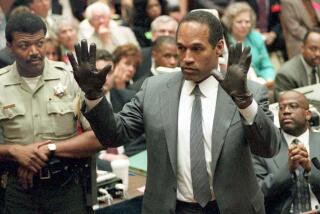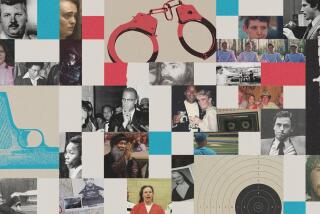Legal Eagles Have Perched on the Air
Cochran bashes Darden. Darden bashes Cochran. Shapiro bashes Bailey. Bailey bashes Shapiro. Book deals. Larry King. Yadda yadda yadda.
The law.
Well, not entirely. It just seems that way if you’re a TV viewer. Nor, their strengths notwithstanding, are NBC’s “Law & Order” and ABC’s “Murder One” designed as primers on the courtroom.
So let’s hear it for Steven Brill, founder and CEO of cable’s 24-hour Court TV network, who this weekend launches a three-hour programming block aimed at educating youths 12 to 18 about the ins and outs of the law, which has taken such an image bruising in an age of televised trials and other spectacular crime cases.
Fun and smart, “Teen Court TV” airs on Saturday mornings and repeats Sunday mornings on Court TV, which got famous, and infamous, while providing pool TV coverage of the O.J. Simpson murder trial.
“Teen Court TV” is not the only series purporting to enlighten viewers about legal matters that inevitably get omitted from TV reports.
“Burden of Proof,” for example, is billed as providing that missing perspective. A direct spinoff from the Simpson odyssey, “Burden of Proof” is a weekday program on CNN that examines topical legal issues with a studio panel and attorney-hosts Greta Van Susteren and Roger Cossack, who were the network’s lead analysts for its coverage of the Simpson murder trial.
CNN created the show in hopes of capitalizing on interest in the law generated by the Simpson trial, and the concept of thoughtful dissection is good. Yet a fixation on headlines and tall-profile cases gives “Burden of Proof” an aura of redundance and knee-jerk shallowness that echoes generic talk shows.
And while emphasizing the law’s nobility over shiny suits, its hosts demonstrate a grating chumminess with celebrity lawyers whose cases they hash over. On a recent show featuring embattled F. Lee Bailey, for example, it was “Lee” this, and “Lee” that, with the panel sitting woodenly, watching hosts who seemed to go out of their way to avoid irritating the often-irritating Bailey, whose next stop on CNN was Larry King.
A ripped-from-the-headlines tone also characterizes “American Justice,” now in its fifth season on the A&E; network. But at least they’re not necessarily today’s headlines.
Hosted by Bill Kurtis from a courtroom, where law books are props, these Wednesday night documentaries are entertaining even when stressing the crime and the criminal (“The Bombers,” for example) instead of broader issues of law.
This week’s fascinating hour managed to do both, reviewing the gore of “The Long Island Railroad Massacre” and the zaniness of the subsequent trial, in which Colin Ferguson insisted on representing himself. Although Ferguson claimed he was innocent of gunning down six train commuters and wounding 19 others in that 1993 massacre, the jury swiftly convicted him after a trial that was called a “theater of the mentally ill” by one of the lawyers whom Ferguson fired.
Although failing to explain the “legal counselors” who sat beside Ferguson, the program clearly defined the legal basis and underlying psychology for defendants representing themselves. The bottom line: They rarely win.
There’s also an educational component implied in the title of “Inside America’s Courts,” the daily program that Court TV syndicates to broadcast stations. Mostly, though, it’s a sort of courtroom “Entertainment Tonight,” with Gregg Jarrett and Kristin Jeannette-Meyers co-anchoring a snappy but repetitious roundup of court cases, from the Menendez brothers to Bernhard Goetz, which ultimately congeal as one in your mind.
When it comes to informing viewers about the law, Court TV saves its best for kids--though, inexplicably, not always at times when the teens it targets can be expected to be in front of the TV.
“Teen Court TV” contains three back-to-back programs, starting with “Your Turn,” a talk-show-style teen meeting that this week originates in Baltimore, where host Carol Randolph skillfully guides a spirited discussion about the law and drugs that includes students, a couple of former abusers and Mayor Kurt Schmoke, who favors downgrading criminal penalties for marijuana possession.
Then comes “Justice Factory,” an MTV-style hour of hot graphics, quirky camera angles and law tidbits hosted by Court TV reporter Jan Rostal, which opens with a tour of the Manhattan district attorney’s office and includes a visit with members of the “Law & Order” cast.
The program, which in future weeks will be half an hour, also features a video competition relating to the law and “Law Daze,” a regular profile of a law student that this week centers on a third-year Fordham Law School student.
The final, and weakest, hour is “What’s the Verdict?,” with Court TV anchor Dan Abrams sitting with three teens who weigh in on a specific trial and serve as its mock jury. On the premiere, it’s the assault trial of Phoenix Suns star Charles Barkley, who was charged in 1994 with striking a fan in the stands after a basketball game in New York.
The Barkley case is the kind that will immediately interest many teens. Good. Two of the teens on the show mumble. That can be fixed.
Yet “What’s the Verdict?” has a structural problem that can’t be resolved as easily. Having the teens judge cases on excerpts is unavoidable, but it also gives the misleading impression that an accurate reading can be obtained from a trial shown in truncated form. Not good.
In any case, all three programs try mightily to educate and spark enthusiasm about the law through a youth prism. It’s a noble effort and, based on this early sampling, a highly promising one.
But elsewhere, Bailey is still attacking Shapiro, and vice versa.
* “Teen Court TV” airs 6-9 a.m. Saturday and Sunday on Court TV, with “Justice Factory” also airing at 3 p.m. Saturday and “What’s the Verdict?” at 3 p.m. Sunday.
* “Inside America’s Courts” airs weekdays at 9:30 a.m. on KCAL-TV Channel 9.
* “Burden of Proof” airs weekdays at 9:30 a.m. on CNN.
* “American Justice” airs Wednesdays at 6 p.m. and 10 p.m. on A&E.;
More to Read
The biggest entertainment stories
Get our big stories about Hollywood, film, television, music, arts, culture and more right in your inbox as soon as they publish.
You may occasionally receive promotional content from the Los Angeles Times.










